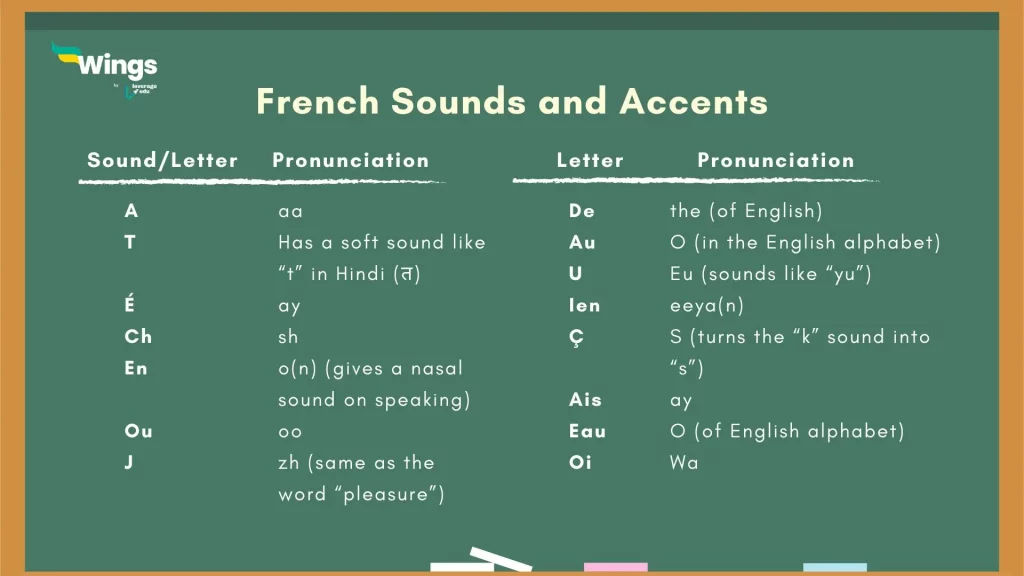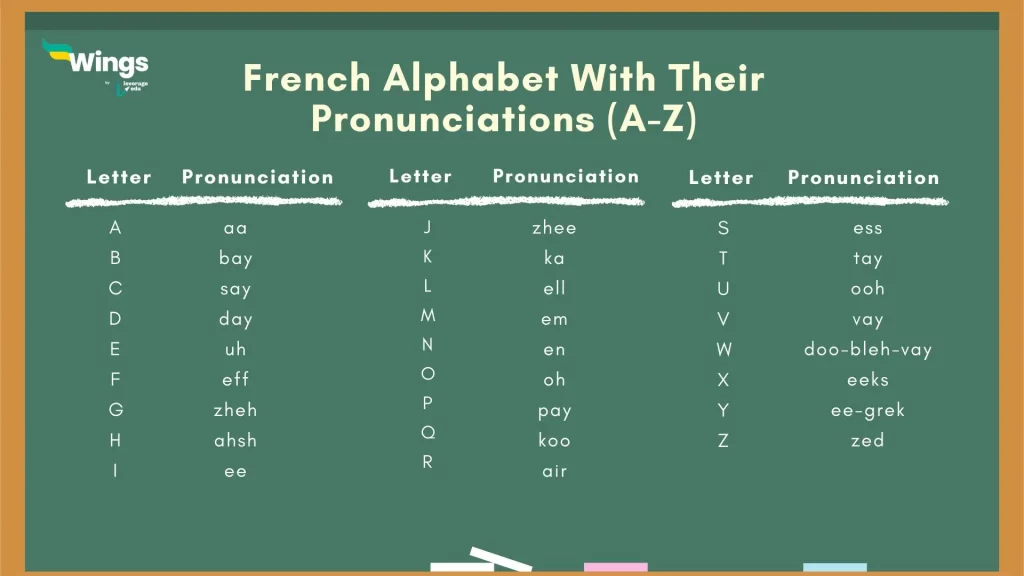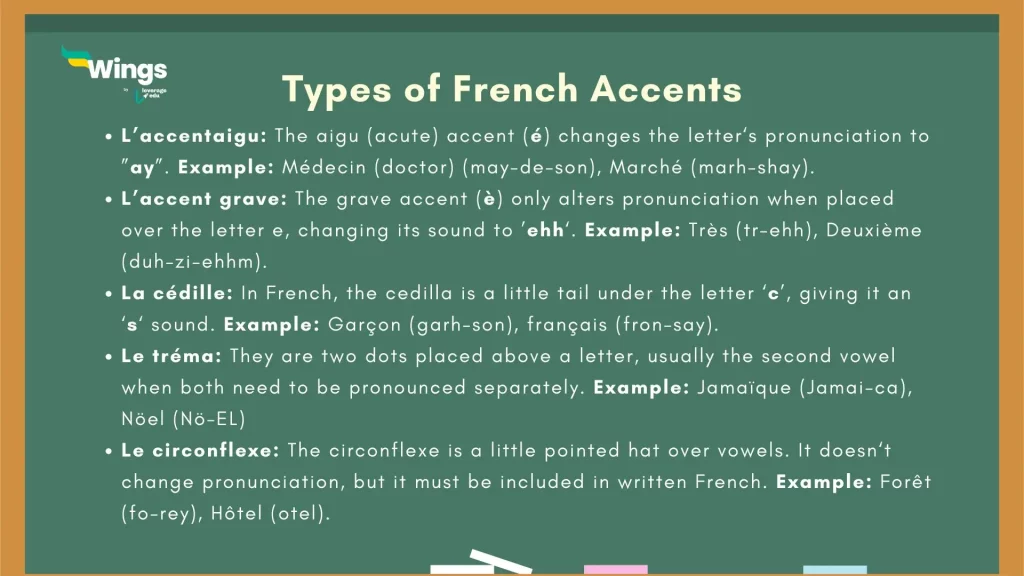Now that we know some basic French words, the French alphabet with pronunciation is our next step! Unlike English, the French alphabet combines different sounds and letters, ultimately producing that world-famous elegant accent that we all love and adore. Don’t worry, this guide will have you sounding sophisticated in no time. We’ll break down each letter, explaining those tricky sounds, and get you speaking French like a pro. So bid “au revoir” to hesitation and “bonjour” to a beautiful French accent. Ready, set, lingo!
This Blog Includes:
Understanding French Sounds
First off, learning the French alphabet involves understanding the different French sounds and accents. Once you go through the following basic set of sounds, you will be able to grasp the French alphabet with pronunciation with ease. Let’s start:
| French Letter/Sound | Pronunciation |
| A | aa |
| T | Has a soft sound like “t” in Hindi (त) |
| É | ay |
| Ch | sh |
| En | o(n) (gives a nasal sound on speaking) |
| Ou | oo |
| J | zh (same as the word “pleasure”) |
| De | the (same as “the” spoken in English) |
| Au | O (same as the English alphabet) |
| U | Eu (sounds like “yu” when spoken) |
| Ien | eeya(n) |
| Ç | s (turns the “k” sound into “s”) |
| Ais | ay |
| Eau | O (spoken like the English alphabet “O”) |
| Oi | wa |

Also Read: Similarities Between English and French
How Does French Alphabet with Pronunciation Sound?
Since French is not a phonetic language (letters not corresponding to a single sound), it’s vital to learn the French alphabet with pronunciation rules. Like English, the French language also has 26 letters, creating more than 35 sounds by combining different accent marks, letters, and their placement in a word. Given below are the French letters with their proper pronunciation:
| Letter | Pronunciation |
| A | aa |
| B | bay |
| C | say |
| D | day |
| E | uh |
| F | eff |
| G | zheh |
| H | ahsh |
| I | ee |
| J | zhee |
| K | ka |
| L | ell |
| M | em |
| N | en |
| O | oh |
| P | pay |
| Q | koo |
| R | air |
| S | ess |
| T | tay |
| U | ooh |
| V | vay |
| W | doo-bleh-vay |
| X | eeks |
| Y | ee-grek |
| Z | zed |
Silent Letters
French is known for its silent letters, which can trip up learners coming from more phonetic languages. Here’s a quick rundown of some general guidelines regarding silent letters in French:
- Final Consonants: Many consonants at the word’s end are silent. This includes letters like d, t, x, p, and g. There’s a handy mnemonic “CaReFuL” to remember consonants often pronounced at the end (C, R, F, L).
- Lettre muette (silent letters):
- H: Silent most of the time, except when paired with C to make the “ch” sound.
- E: Usually silent at the end of a word unless it has an accent (é). It affects the pronunciation of the preceding vowel.
- U: Silent after G or Q, but it modifies the G sound.
- N: Can be silent when combined with another consonant to create a nasal sound (en, an).
- I: Silent after O, forming the “wa” sound (oi).

You can also refer to this tutorial below for more help with the pronunciation of the French alphabet:
Also Read: How to Learn French Quickly? Here are 10 tips to Master the Language!
French Alphabet with Pronunciation: Accents
Learning the French alphabet with pronunciation also involves understanding the different accents that come with it. The French language uses 5 diacritical marks on the vowels a, e, i, o, u, and the consonant c, which changes their pronunciation and sometimes even their meaning. The 5 primary French accents are as follows:
L’accent Aigu
The aigu (acute) accent (é) changes the letter‘s pronunciation to ”ay”. Example: Médecin (doctor) (may-de-son), marché (marh-shay).
L’accent Grave
The grave accent (è) only alters pronunciation when placed over the letter e, changing its sound to ’ehh‘. Example: très (tr-ehh), deuxième (duh-zi-ehhm).
La Cédille
In French, the cedilla is a little tail under the letter ‘c’, giving it an ‘s‘ sound. Example: Garçon (garh-son), français (fron-say).
Le Tréma
They are two dots placed above a letter, usually the second vowel when both need to be pronounced separately. Example: Jamaïque (Jamai-ca), Nöel (Nö-EL)
Le Circonflexe
The circonflexe is a little pointed hat over vowels. It doesn‘t change pronunciation, but it must be included in written French. Example: Forêt (fo-rey), Hôtel (hotel).

French Alphabet with Pronunciation: Vowels and Consonants
Compared to English, French vowels and consonants are a whole different beast. There are 6 vowels in French (A, E, I, O, U, Y) with 12 distinct sounds, while French consonants can be tricky because pronunciation often depends on surrounding letters. Let’s look at them in more detail:
Vowel Sound Production
- Oral vs. Nasal: Unlike English, French boasts nasal vowels where air flows through both the mouth and nose (an, on, in, etc.).
- Tongue Position: French vowels are categorized by tongue height (high, mid, low) affecting the sound (e.g., “i” vs. “a”).
- Silent “e”: The letter “e” at the end of a word is usually silent but influences the pronunciation of the preceding vowel.
Pronunciation of Consonants
- Silent Letters: French has many silent consonants, particularly at the word’s end (t, d, p, x, etc.).
- Double Consonants: Though written double, consonants are usually pronounced as a single sound (e.g., “ll” in “belle”).
- C & G: Their pronunciation depends on following vowels (hard “k” or “g” with “a, o, u”; soft “s” or “j” with “e, i, y”).
- Liason & Enchaînement: Consonants at the end of a word can link with the vowel of the next word, creating a smoother flow.
Quiz on French Alphabet with Pronunciation
Q1 – True or False: There are 26 letters in the French alphabet.
Q2 – Fill in the Blank: The accent _________ changes the sound of letter “c” from “k” to “s”.
Q3 – Match the following letters with their correct pronunciation:
| a) W | 1. air |
| b) G | 2. ee-grek |
| c) Y | 3. doo-bleh-vay |
| d) R | 4. zheh |
Q4 – True or False: The silent letter “U” modifies the Q sound when placed after it.
Answers: A1 – True, A2 – Cédille, A3 – a): 3; b): 4; c): 2; d) 1, A4 – False
Relevant Reads:
FAQs
Ans: Oui! French has quite a few silent letters, especially at the end of words. Letters like d, t, x, and p are often silent. There are even some silent vowels, like the “e” at the end of many words.
Ans: This might surprise you, but even though French has just 6 vowel letters (A, E, I, O, U, Y), they can create 12 distinct vowel sounds! French vowels are all about tongue placement and whether they’re nasal or oral sounds.
Ans: In French, consonants written double (like “ll” or “ss”) are usually pronounced as a single sound. So, “belle” (beautiful) wouldn’t have a long “L” sound, but just a regular “l”.
And we are done with the French alphabet with pronunciation for today. Explore Leverage Edu’s study abroad resources to learn a new language of your choice. Ready, set, lingo!
 One app for all your study abroad needs
One app for all your study abroad needs















 60,000+ students trusted us with their dreams. Take the first step today!
60,000+ students trusted us with their dreams. Take the first step today!